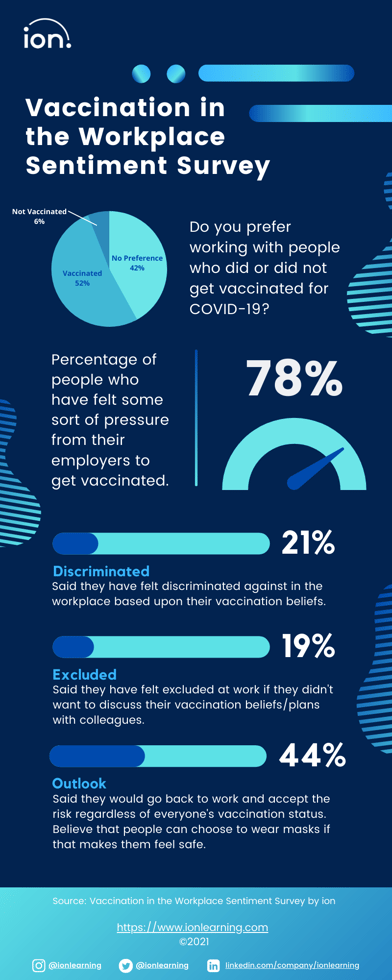Results: Vaccination in the Workplace Sentiment Survey
Have you felt pressure from your employer concerning your vaccination status? If you answered “yes,” then, apparently, you are not the only one who feels this way. Reports show that companies are excluding employees from going back to work and others have shared that their peers are shaming each other about their stance on vaccinations.
It appears that we have discovered a new bias. Vaccination bias is showing up in a few ways: bias toward people who are for the vaccine, against, and even on the fence. We don't think it’s people's intentions to exclude and alienate based on private medical decisions, but that is the impact that many people are experiencing.
In order to get some more perspective, we ran a "Vaccination in the Workplace Sentiment Survey" asking a variety of questions about feelings of discrimination, exclusion, and pressure regarding vaccination status — and preferences for going back to the office. Our goal for this survey was to bring some perspective around others' experiences in the workplace when it comes to their vaccination beliefs, and guide organizations to make more informed decisions that include all.
Key Findings
Below are highlights from the survey’s results. You can also download this infographic at the end of the post for sharing purposes.

Pressure
Our largest percentage came from respondents who said that they felt some sort of pressure from their employer to get vaccinated (78%). The intensity of the pressure people felt varied from a little to a lot. 25% of respondents indicated they felt an immense amount of pressure to be vaccinated.
Return to Office
Overall, the majority of respondents (44%) noted that they would go back to work and accept the risk of contracting COVID-19 regardless of everyone's vaccination status. The second-highest option for being comfortable returning to work was only if everyone WAS fully vaccinated and no proof was needed (14%).
Preference
Respondents were invited to choose whether they preferred working with others who did or did not get vaccinated for COVID-19. About a half said that they would prefer their colleagues to be vaccinated (51%), while those who said that they had no preference for coworkers’ vaccination status fell closely behind (43%). The smallest group were those who said that they would prefer working with others who were not vaccinated (6%).
Bias
There were participants who noted that they felt discriminated against within their workplace based upon their vaccination beliefs (21%). When participants were asked if they felt excluded at work if they didn't want to discuss their vaccination beliefs or plans with colleagues, a similar percentage of participants noted that they did (19%).
Recommendations
Based on these key findings, here are some action items suggested by the National Safety Council that can prevent vaccination bias in your workplace:
- Listen more than you talk: Be positive, inviting, and respectful. Acknowledge “the choice is yours to make with your doctor or health care provider.”
- Lead with empathy: Don’t talk down to people, lecture, or make people feel guilty. Instead, be understanding, positive, and hopeful.
- Respect concerns: People may be concerned about the vaccine for different reasons, from historic and current racism in health care, to concerns about the safety of the vaccine, to misinformation and rumors spreading on social media.
- Keep politics out of it: Getting vaccinated is a deeply personal choice, and people want to keep politics out of it.
- Create a safe space for those who choose not to get vaccinated: The fact is that no community or individual shares all the same beliefs, perceptions, and concerns. Ultimately, it is important to create a safe, supportive workplace culture where all workers feel respected.
Methodology
For this survey, we reached out to various groups ranging from those in our network to a broader audience online for a month starting in June of 2021, utilizing a wide range of channels: a portion of survey responses came from email invitations (e.g. mailing lists consisting of clients and readers); another portion came from social media posts and survey tools (e.g. Facebook, Twitter, LinkedIn, SurveyMonkey and Survey Circle). Respondents were asked to complete a short online questionnaire which was conducted in English.
We collected 300 responses during this survey. This is the sample we used to calculate all numbers cited in this report; no weights were applied to the results and no data cleaning was done. Respondents represented a wide range of perspectives, including age, gender, work department, company size, and job title.
We are very grateful to all of the ion Insiders and online communities who took the time to share their experiences with us. This collaborative research work is key to making informed decisions about how we handle biases in the workplace — and we look forward to hearing your thoughts on these findings.
Click here to download a shareable infographic on our findings.
All the best!
ion Team






